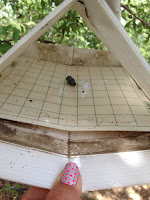Despite the sunrise-to-sundown work schedule, the
Fourth of July holiday brought a welcome, but brief respite for growers – a
time for barbecues, fireworks and get-togethers with friends and family. But
there’s no rest for the weary.
 |
| Almonds are heading into hullsplit around the valley. |
Almond
growers, for instance, are keeping an anxious eye on their crop as it heads
toward the backstretch to harvest time. Field scout Jenna Horrine reports
growers are figuring out the timing for hullsplit sprays to protect against
crop-damaging pests.
UC IPM and extension advisors recommend growers
follow an IPM and resistance-management approach to managing navel orangeworm
(NOW) and spider mites. Most growers will spray for NOW at hullsplit and many
make another application two or three weeks later.
 |
| Monitor for pests before treatment. |
 |
| Check traps for pest eggs. |
Weekly monitoring of spider mites and predators should determine if miticide applications are needed.“When monitoring for spider mites, PCAs should also be looking for six-spotted thrips, predatory mites, spider mite destroyers and minute pirate bugs,” says David Haviland, an entomologist and almond expert with UC Cooperative Extension in Kern County.
UC guidelines call for treating for mites if half of the leaves sampled have mites. If there are no predators, then treatment should be made if 25 percent of the leaves are infested.
Jenna again stresses this is the time to closely monitor their orchards to keep on top of the pests and avoid a sudden population explosion just before harvest. Jenna says one orchard is already seeing the first signs of the hulls splitting. Other growers are expecting the almond hulls to start splitting soon.
 |
| Cotton plants are starting to experience bloom in the field. |
Before we know, harvest time will be here. Jenna notes the earliest tree shaking last year came on July 25.Shaking time is around the corner.Meanwhile, field scout Carlos Silva says cotton growers are wrapping up the second irrigation of the growing season. The plants are at the colorfully flowering stage, lighting up fields with various shades of pink, white and yellow. So far, there aren’t any major issues with pests.
In alfalfa, growers are pretty much finished with another cutting and leaving strips of uncut alfalfa to keep lygus from migrating to nearby cotton fields. “There are a lot of beneficial insects in the alfalfa fields,” Carlos says.

Field
Day Alert: Growers are invited to attend a Summer
Alfalfa Field Day on Wednesday, July 15 from 10 a.m. to 12:30 p.m. at Bowles Farming at the intersection of Hereford Road and Bisignani
Road in Los Banos. The speakers are UC IPM advisor Dr. Pete Goodell on insect
management; UCCE Davis alfalfa extension specialist Dr. Dan Putman on current
issues, including weeds, water quality and availability and summer retirement
of alfalfa fields; Merced County Deputy Agricultural Commissioner Sean Runyon
on an update of chlorpyrifos regulations; and Cannon Michael of Bowles Farming.
Continuing education credits should be available. For more information contact
Marcia Gibbs at (530) 370-5325
or marcia@sustainablecotton.org
ReplyDeleteشركات نقل عفش واثاث بجدة
شركات نقل عفش بالطائف
اسعار وارقام شركات نقل العفش بالمدينة المنورة
دينا نقل عفش جدة ,افضل دينا